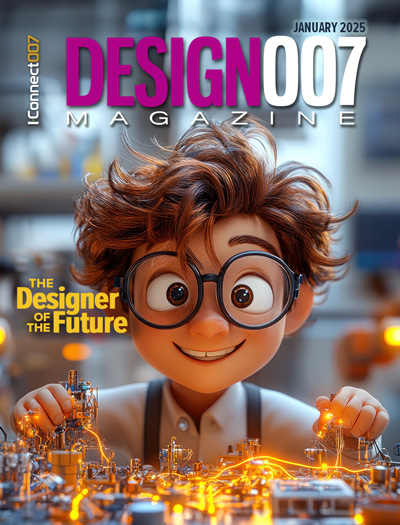-

-
News
News Highlights
- Books
Featured Books
- design007 Magazine
Latest Issues
Current Issue
Learning to Speak ‘Fab’
Our expert contributors clear up many of the miscommunication problems between PCB designers and their fab and assembly stakeholders. As you will see, a little extra planning early in the design cycle can go a long way toward maintaining open lines of communication with the fab and assembly folks.

Training New Designers
Where will we find the next generation of PCB designers and design engineers? Once we locate them, how will we train and educate them? What will PCB designers of the future need to master to deal with tomorrow’s technology?

The Designer of the Future
Our expert contributors peer into their crystal balls and offer their thoughts on the designers and design engineers of tomorrow, and what their jobs will look like.
- Articles
- Columns
Search Console
- Links
- Media kit
||| MENU - design007 Magazine
Estimated reading time: 1 minute
Beyond Design: Practical Signal Integrity
"There are two types of designers: Those that have signal integrity problemsand those that will." — Sun Microsystems.
If you are a digital designer, you will eventually have SI problems whether you like it or not. But all is not lost. If you learn to work with these issues, then you will soon become proficient with high-speed design.
Advances in semiconductor lithography enable IC manufacturers to ship smaller and smaller dies. However, Moore's law (1965) is still in effect: The number of transistors on ICs doubles every two years and will continue for at least 10 years. Arguably, the predictions about the law were short-sighted, and the paradigm will continue to apply as chip sizes continue to scale down. But keeping up with it is becoming more challenging. Intel for instance, changed transistor structure into 3D form, by placing transistors on top of each other, on the latest 22 nm process to enable them to continue shrinking silicon.
Each new generation of semiconductor process technology delivers greater levels of integration, higher performance and lower cost. However, these benefits are offset by increases in power consumption that seem to unavoidably accompany each reduction in feature size. In order to reduce power consumption, IC manufacturers have moved to lower core voltages and higher operating frequencies which of course mean high current requirements and faster edge rates.
Faster edge rates mean reflections and signal quality problems. So even when the package and your clock speed haven’t changed, a problem may exist for legacy designs. The enhancements in driver edge rates have a significant impact on signal quality, crosstalk, timing and EMI. So whether you like it or not,welcome to the domain of high-speed design.Read the full column here.Editor's Note: This column originally appeared in the August 2013 issue of The PCB Design Magazine.
More Columns from Beyond Design
Beyond Design: Key SI Considerations for High-speed PCB DesignBeyond Design: Electro-optical Circuit Boards
Beyond Design: AI-driven Inverse Stackup Optimization
Beyond Design: High-speed Rules of Thumb
Beyond Design: Integrated Circuit to PCB Integration
Beyond Design: Does Current Deliver the Energy in a Circuit?
Beyond Design: Termination Planning
Beyond Design: Dielectric Material Selection Guide


